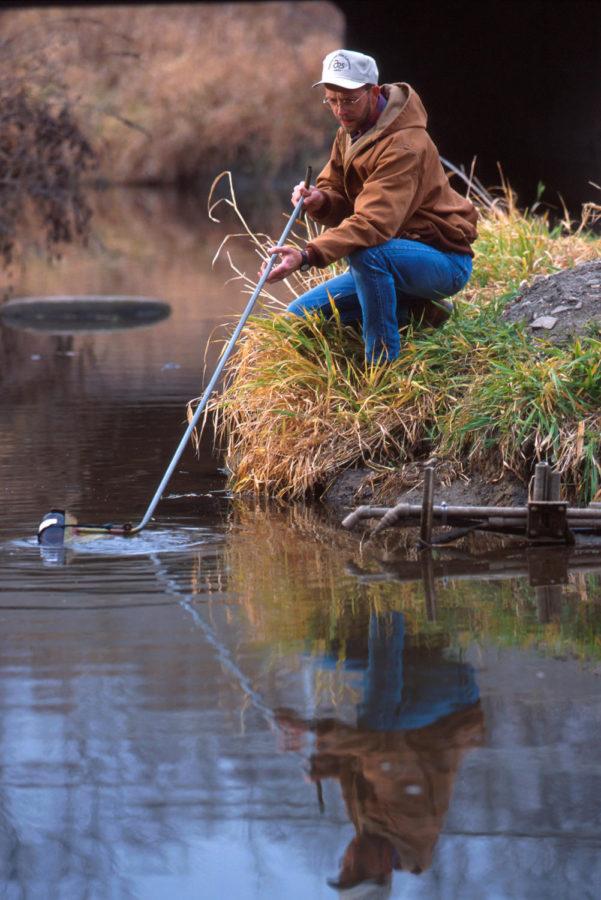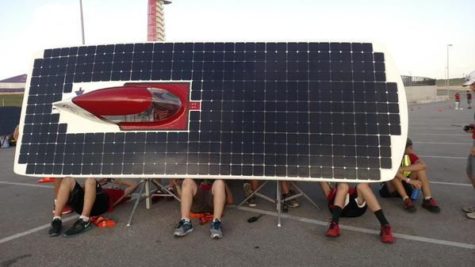List of 10 nutrient projects
Jeff Nichols, a technician at the National Laboratory for Agriculture and the Environment, collects a water sample from Walnut Creek south of Ames. The U.S. Department of Agriculture is studying the effects of farming practices on water quality.
September 25, 2014
Ten new projects at the Nutrient Research Center:
- Stream nitrate trends affected by farming practices in the Walnut Creek watershed
- Issue: Nitrate concentrations and phosphorus levels have been monitored to track farming practices.
- Objective: Monitor weather and changing crop patterns’ effects on water quality.
- Phosphorus loss from Ephemeral Gully
- Issue: Phosphorus impacts water quality. Tracking the source of phosphorus and how much phosphorus is lost from farm fields is difficult.
- Objective: This new study may be able to track the phosphorus source.
- Modeling of nitrate loads and concentrations in Raccoon River
- Issue: Stream water quality is strongly linked to land use, hydrology and precipitation. Understanding how climate and weather link to production practices, and how this affects environmental outcomes, is crucial to quantify water quality improvements.
- Objective: This project will develop statistical models to describe changes in seasonal concentrations and loads of nitrate in the Raccoon River.
- Developing remote sensing protocols for inventory of nutrient management practices.
- Issue: An accurate inventory of in-field and off-site nutrient management practices.
- Objective: This project will develop standard remote sensing protocols to inventory cover crops and residue cover. These protocols will be validated in the Turkey River, Cedar River and Skunk River watersheds.
-
Drainage water quality impacts of future agricultural practice
-
Issue: The Iowa Nutrient Reduction Strategy focuses on reducing downstream nutrient loss and evaluate how crop rotation may impact nutrient loss through drainage systems.
-
Objective: This study will evaluate the crop production and drainage water quality impacts of various cropping and nutrient management systems.
-
- Nutrient trading in Iowa – a study in the Catfish Creek watershed
- Issue: Water quality can decrease when nutrients such as phosphorus and nitrogen leave farm fields.
- Objective: Nutrient trading can improve water quality and safe farmers money.
- On-farm demonstration and workshops
- Issue: Contour prairie strips reduce surface nutrient runoff for about the same cost as cover crops. The effectiveness of this practice will depend on rate of adoption and continued maintenance.
- Objective: To establish a clearer understanding the best practices of prairie strips.
- Remote sensing protocols of vegetative practices
- Issue: The Iowa Nutrient Reduction Strategy needs an accurate inventory of in-field and off-site nutrient management practices.
- Objective: Develop remote-sensing protocols for the inventory and monitoring two permanent vegetative conservation practices – riparian buffers and grassed waterways.
- Measuring the effectiveness of stacked nutrient reduction
- Issue: Insufficient monitoring of detecting when water quality improves has been difficult to help identify best management practices.
- Objective: A paired watershed study design could overcome these issues
- Scientific and technological tools to implement the Iowa nutrient reduction strategy
- Issue: New scientific tools are needed to help detect when nutrients are transported through Iowa.
Here are a few tools from the final project:
Bioreactors: Handy little underground trenches filled with wood chips that help maintain nutrients in the soil.
Saturated buffers: Maintain the water levels in a field, so during heavy rain the crop will not drown.
Remote sensing and spreadsheets: Help farmers know how, when, and what to plant in their particular field.
Cover crops: A crop planted during the “off season” to help maintain nutrients that would otherwise be washed away.
















